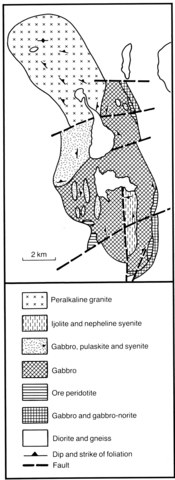stripes
This layered multiple-phase complex having an area of about 100 km2 is confined to the Archaean Kola series. The complex is built up in three phases, each being represented by a layered, spatially distinct group of rocks. The earliest phase comprises peridotite-clinopyroxenite, gabbro, akerites and pulaskites, which make up the larger part of the south of the complex. The second phase consists of a series of melteigites, ijolites, urtites and nepheline syenites which are also concentrated in the southern part of the complex. Igneous activity was completed by the intrusion of a peralkaline, but more siliceous, magma which formed the large body of aegirine granite, nordmarkite and alkaline pulaskite in the northern part of the complex. The melteigite-ijolite-urtite series comprises nepheline, aegirine-augite and biotite with subordinate alkali feldspar, titanite, calcite, magnetite, apatite and zircon. The nepheline syenite series is somewhat more complex and ranges from foyaite and foyaite pegmatite to peralkaline syenite. The principal minerals are microcline, nepheline, aegirine, albite and minor apatite, calcite, prehnite, pyrochlore and zircon. The peralkaline granites contain arfvedsonite and minor aenigmatite, astrophyllite, chevkinite, orthite and fergusonite. Concentrations of rare earth minerals, zircon and pyrochlore are associated with the ijolite-urtite series, the latter mineralisation being of autometasomatic and metasomatic type.
KUKHARENKO, A.A., BULAKH, A.G., IL'INSKY G.A., SHINKAREV, N.F. and ORLOVA, M.P. 1971. Metallogenic peculiarities of alkaline formations of the eastern part of the Baltic shield. Trudy Leningradskogo Obshchestva Estestvoispytatelei, 122 (2): 278 pp.
PUSHKAREV, Yu.D., OSOKIN, A.C., KRAVCHENKO, M.P. and RYUNGENEN, G.I. 1987. Isotope composition of lead and strontium in apatites from the Gremyakha-Vyrmes alkaline massif as a basis for the determination of the age and source of the primary magmatic melt. In Abstracts of All-Union School Seminar 'Methods of isotope geology'. 1-13 December 1987. Moscow. 174-5.
SHANIN, L.L., KONONOVA, V.A. and IVANOV, I.B. 1967. On the application of nepheline in K-Ar geochronometry. Izvestiya Akademii Nauk SSSR, Seriya Geologiya, 5: 19-30.

